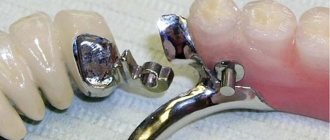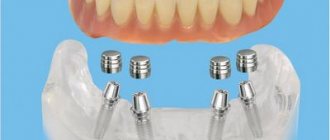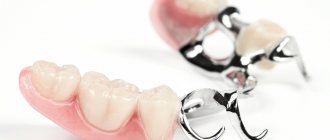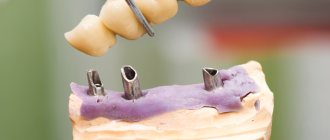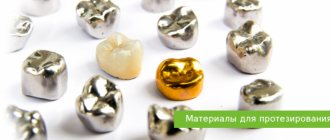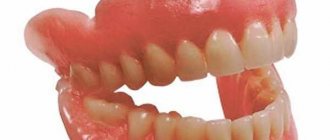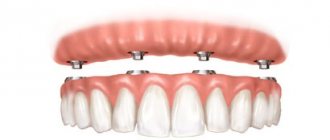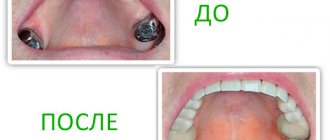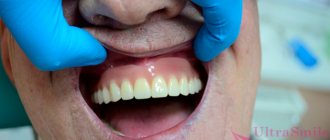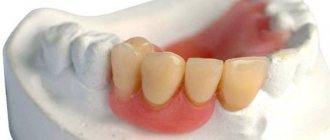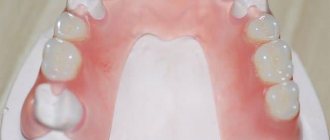From this article you will learn:
- what is clasp dental prosthetics?
- important features of these prostheses,
- clasp dentures – reviews, price 2021.
Clasp dentures are a type of removable dental prosthetics in dentistry, a characteristic feature of which is the presence of a metal arch (clasp) in the prosthesis. This arch gives the prosthesis special strength and can significantly reduce the volume and thickness of the base made of plastic or nylon. Thus, the prosthesis takes up significantly less space in the oral cavity and, for example, on the upper jaw it will no longer completely cover the palate.
Reviews of clasp dentures confirm that they are the most effective type of removable dental prosthetics. They are better than all other types of removable dentures - 1) they well compensate for lost chewing efficiency, 2) they are well fixed on the teeth, 3) they are comfortable when chewing and speaking, 4) they do not impair diction, 5) they have a long service life. These dentures can only be used in those patients who at least partially retain their own strong teeth, and these teeth should be on both sides of the jaw.
What are clasp dentures - design features, scope, pros and cons
Article navigation
- Features of the models
- What is the difference between clasp designs?
- Indications and contraindications
- What types of structures are there?
- Which prostheses are best to choose?
- Manufacturing and Installation Principles
- Advantages and disadvantages
- Clasp dentures: photos BEFORE and AFTER
- How long will the system last?
- Clasp systems - cost
- Alternative options
Question for a specialist
Clasp dentures are one of the most popular types of dental prosthetics.
They consist of several main parts - a metal arch (also known as a clasp) is considered the base of the structure, on which artificial gums made of plastic are fixed, as well as dental crowns. Clasp dentures allow you to replace only part of the missing teeth, since they require at least two supports to fix them. They cannot be attached only to the gums due to their metal base.
Care products
Modern means for caring for dentures are varied and more effective than the old-fashioned solutions with soda and potassium permanganate, which will do more harm than good. They are specially designed for different types of structures, therefore they are absolutely harmless.
Care products can be fixative or cleansing. The most popular of them are fixing adhesives and creams. They contribute to a reliable fit of the prosthesis and redistribution of the load during chewing. It prevents food debris from getting under them and does not rub the gums, since the glue creates an airtight cushion. At night, the structure with fixing substances must be removed, this is the condition for their use.
Fixing powder is suitable for people with weak salivation. A thin layer of powder is applied to the structure, which is pressed tightly against the gums, creating an obstacle to food particles. And strips of special canvas for fixation are necessary if a person has an abnormal jaw structure.
Another common remedy is special tablets that dissolve in water. This solution can not only clean dentures, but also whiten them. True, they do not work on persistent nicotine stains; you will need the help of a dentist who will remove them with ultrasound. This needs to be done every six months.
Rinsing, cleaning, disinfection, professional care - these are the main components of the care process. And what means are used for them will depend on the specific model of prostheses.
What is it - design features of the models
Answering the question of what it is - a clasp prosthesis, what it looks like and how it differs from all the others - you should immediately note that such a design refers to removable prosthetics. After installation, the product transfers the load not only to the supporting teeth, but also to the mucous membrane, thereby ensuring a more correct distribution of chewing pressure throughout the jaw. As mentioned above, the design is based on a strong frame in the form of an arc - this is the clasp. It should also be noted that such systems are used exclusively for partial replacement of missing teeth in a row. Supports are needed to fix them, so the “clasp” is not suitable for solving the problem of complete edentia.
BEST REMOVABLE DENTURE - 20,000 rub.
All manipulations for the manufacture, installation and fitting of the prosthesis, including impressions, are included.
Save RUB 10,000! >> Call now or request a call
Opening hours: 24 hours a day - seven days a week
Clasp dentures can be made and fixed on both the upper and lower jaws, but installation on the upper jaw is especially preferable. The product for the upper jaw is devoid of a massive bridge - which blocks the palate, can cause attacks of nausea and noticeably distorts the taste of your favorite dishes. The bridge of the clasp prosthesis is very thin, but strong, it causes almost no discomfort.
By the way, the clasp device does not have to be removed while sleeping. It is enough to remove the structure after eating for cleaning and disinfection. This will make it much faster and easier to get used to.
Types of orthopedic structures
The classification identifies several options for acetal dentures. Depending on the location of installation, it can be on the lower or upper jaw. In length – an immediate prosthesis (“butterfly”) for 1-2 teeth and an extended orthopedic structure that restores multiple and/or scattered defects in a row. As a rule, the last option is most often used, because The material is too hard for a butterfly.
As for popular varieties, they can be as follows:
- prosthesis with acetal clasps,
- clasp acetal dentures for the upper and lower jaws.
Clasp prosthesis made of acetal (without metal)
Such a device can be called a complete analogue of the clasp one. Only in acetal, the arch or frame is made of white acetal - there is no metal at all in this orthopedic design. Pink gum is built up on top of the arch; it can also be made of acetal or more transparent and elastic acrylic. Hooks or clasps are also made of acetal. Artificial teeth can be made from the same material, or they can be made from more pliable plastics. For attachment to the upper jaw there is an acetal palatal bridge. According to patient reviews, acetal dentures are lighter than classic clasp dentures with hooks, and are fixed in the oral cavity just as reliably.
Clasp metal with acetal clasps
In a traditional clasp denture, there is a metal arch inside and metal clasps on top - they grip the supporting teeth like small processes or “claws”. But when you smile, gray clasps can be noticeable. Therefore, it is allowed to make hooks from acetal, but leave the arc metal.
Read more about all possible prosthetic options for partial absence of teeth on one or two jaws.
How do clasp structures differ from other types of prostheses?
As we have already found out, the key difference between this orthopedic system and plate, nylon and other acrylic models is the presence of a cast strong frame in the form of an arc. During the production of the product, a pink plastic base is literally built onto it, and then artificial crowns are attached. It is this frame that makes it possible to significantly reduce the volume and thickness of the base, which significantly improves comfort for the patient.
The pink base, which imitates natural gum, is usually created from acrylic plastic. However, today, at the request of the patient, it can also be made of Acry-Free material - more flexible and pliable, but at the same time strong enough to successfully cope with intense chewing loads. This material can easily be called an improved acrylic of a new generation, but in this case the cost of restoration will be higher.
What material is used
Acetal (more precisely, polyacetal, polyformaldehyde, polyoxymethylene) is an organic thermoplastic compound discovered about 100 years ago. The material is initially crystalline and has a white, or rather milky color, and is opaque. Some manufacturers color the material according to the Vita scale in 15-17 shades for artificial teeth and pink shades for gums. The material is supplied marked: “Acetal plastic” or “monomer-free acetate plastic”. Quality brands – Evihard, Nuxen, Pressing Dental Srl
Acetal is hydrophobic, i.e. does not absorb oral fluid, saliva, or water at all. It is resistant to alkalis, but can be destroyed in an acidic environment, so you should be careful when consuming acidic foods and drinks.
In terms of strength, polyacetal can be compared with a cobalt-chromium alloy - they have approximately equal characteristics in terms of distribution of chewing load, resistance to abrasion and deformation during long-term use. The material melts at a temperature of 180 degrees Celsius, i.e. You can safely consume hot food and drinks. The absence of toxic acrylic monomer in the composition greatly reduces the risk of an allergic reaction.
Indications and contraindications for installation
Such orthopedic systems are widely used only for partial restoration of the jaw - since their reliable attachment requires the presence of healthy teeth in the oral cavity. Among the main indications for installing a clasp, experts in the field of prosthetics identify the following conditions:
- the absence of one or more teeth: allows you to restore missing elements or close several gaps scattered in a row,
- missing front or side teeth,
- the presence of increased abrasion, weakness of enamel,
- the possibility of restoration in case of periodontitis and periodontal disease, when tooth mobility is observed: it allows them to be securely fixed in a certain position and therapeutic treatment of the disease is carried out, in which the ligaments that hold the tooth in the socket are restored.
Clasp dentures are not used to restore the outermost teeth in a row - end defects. In this case, only one support remains, and the structure cannot be securely fixed. Also, clasp prosthetics is impossible if there is a problem of complete adentia, when there is a lack of all teeth in the oral cavity (in this case there is not a single support for fixing the product).
“I’m 67 now, and literally five years ago almost all of my upper teeth fell off, but a couple remained. Several times I installed a regular removable denture, but it was very uncomfortable, and in the morning I generally had a gag reflex. Then, when I came to visit my eldest son in Moscow, he took me to his friends’ dentistry. There they offered me a clasp prosthesis. It turned out, of course, more expensive, but the difference is colossal! Very comfortable, no nausea. After those ordinary false jaws, it now seems as if there is nothing superfluous in the mouth, as if these are your own teeth.”
Sergey Mikhailovich K., Nizhny Novgorod, from correspondence on the forum www.32top.ru
Naturally, the problem of fixing dentures can be solved by installing implants - they will allow you to securely fix the structure in the oral cavity even in the absence of remaining natural teeth.
Types of prostheses by type of fastening
Clasps are metal arches. Welded to the prosthesis
- Pros. The type of fastening is simple and economical, the open sky increases the comfort of use. In the treatment of periodontitis, clasp dentures act as a splint for supporting teeth.
- Minuses. They spoil the aesthetics. Load: 1/3 on teeth, 2/3 on gums.
Attachments are locks. Provides rigid fixation
- Pros. There is no play, they look aesthetically pleasing.
- Minuses. They cost more, you need to process 2 healthy teeth for the counter grooves for the lock. Load: 1/2 on teeth, 1/2 on gums.
Telescopic crown. Consists of 2 parts - supporting and removable
- Pros. The most aesthetic fastener.
- Minuses. It is necessary to process the teeth for crowns, ensuring that the supporting part matches the removable part perfectly. This requires virtuoso skill as well as high-tech equipment. It costs expensive.
What types of structures are there?
There can be several types of clasp dentures: depending on the method of their fixation in the oral cavity, as well as the materials used to create the structure. The gums, as a rule, are created exclusively from plastic - harder or softer (depending on the indications and general financial capabilities of the patient). Crowns are presented in a wider variety: here are budget metal-plastic (this is the main option), all-ceramic or made from metal-ceramic. And also the most expensive options are made from zirconium dioxide. But, as a rule, almost everyone without exception chooses plastic as the cheapest option, because... other materials greatly increase the cost of the prosthetic structure.
PROSTHETICS WITH 6 OSSTEM IMPLANTS FROM RUB 200,000.
Complex implantation Osstem (South Korea) with delayed loading after 4-6 months.
Call now or request a call
According to the method of fastening, they are divided into three main types (listed in ascending order of cost):
- with clasps - hooks,
- with attachments – locks,
- with telescopic crowns that are installed on top of the supporting teeth.
On hooks (clasps)
Fixation with clasps is one of the most popular methods of attaching a clasp prosthesis, since it is the most affordable from an economic point of view. Consider the characteristics in the following table.
| Description | Clasps are the most common metal hooks, which are a continuation of the prosthesis support and are located above the gum of the supporting teeth, making it possible to firmly and reliably fix the product. As a rule, at least 2-4 hooks are required to securely fix the prosthesis in the oral cavity |
| Advantages |
|
| Flaws |
|
Systems with fastening on locks (attachments)
Clasp orthopedic structures fastened with locks (attachments) are considered to be of higher quality than “clasp” ones, both in terms of comfort and aesthetics. Their description, advantages and disadvantages are disclosed in the following table.
| Description | Attachments are clasps consisting of two elements. The first part of the structure is fixed inside the supporting living tooth; it is covered with a crown on top to give it hardness and strength. But the second part is inside the prosthesis itself |
| Advantages | high aesthetics due to the absence of a visible part of the fastening, quick adaptation due to the absence of metal hooks, reliability of attachments and all structures, reliable fixation in the oral cavity |
| Flaws | high cost, which is explained by the complex fastening system, the difficulty of removing the structure from the supports, the abutment teeth require strong grinding, over time, damage to the abutment teeth is possible due to the heavy chewing load |
On telescopic crowns
Telescopic crowns are one of the most expensive fixation options. Because such a mount is quite complex in terms of manufacturing. But at the same time it is also of the highest quality. The characteristics of such structures are indicated in the table below.
| Description | Instead of hooks and locks, there are crowns designed for fixation on supports. And the supports, in turn, are depulped in advance and covered with crowns of slightly smaller diameter. As a result, such a connection is likened to a nesting doll or retractable sections of a telescopic pipe - it turns out that a crown is put on a crown. And they must connect perfectly - so that the prosthesis does not slip off the support-crowns and at the same time does not press excessively. No cements or screws are used for fixation - only filigree manufacturing precision and tight contact between the telescopic crowns |
| Advantages |
|
| Flaws |
|
There are also models with a splinting effect - with special claw-like processes to stabilize the position of movable units. This is a separate type that allows you not only to restore the appearance and functionality of your smile, but also to reliably fix loose elements, preventing their premature loss.
Video example of clasp dentures with locks
What is the structure?
The name of the prosthesis comes from the German language, where the word “bugel” means “arc”. The product in question consists of the following elements:
- a metal frame that follows the shape of the dentition;
- gums made of elastic material;
- a certain number of artificial teeth;
- elements for fastening to the jaw.
During a conversation or eating, the products will not move or fall out. However, the patient or doctor can remove them themselves with some effort. The orthopedic device feels comfortable in the patient’s mouth and is almost invisible to others.
Which clasp dentures are best to choose?
The cheapest is considered to be a prosthetic design with conventional hooks (clasps). It is inconvenient, causes discomfort while wearing and when eating, getting used to it takes weeks, but it is easy to care for, and the price is pleasing to the wallet. Although this design is about 2 times more expensive than a conventional removable one - a plate one, for example.
The most expensive is considered to be an orthopedic design with telescopic crowns, but it is the most reliable and comfortable. This type is considered conditionally removable prosthetics, since it is very securely fixed in the oral cavity and does not require daily removal. “Bugel” with attachments is the most affordable option in terms of price and quality ratio.
What is important to pay attention to!
The most important part of the clasp prosthesis is its metal frame with a fixation system built into it. Initially, the frames of clasp dentures were made only by casting, for which a cobalt-chromium alloy (CCH) was used. Nowadays, the method of one-piece casting on a refractory model is still widely used, but more modern methods have now appeared that make it possible to increase the accuracy of the manufacture of this prosthesis in the dental laboratory.
For example, frames can be made using the modern method of “selective laser melting”, not only from CCS, but also from titanium. The use of titanium made it possible to both increase the strength of the metal frame (titanium is 5 times stronger than KHS) and reduce the weight of the clasp prosthesis by approximately 2 times. Reducing the weight of the prosthesis greatly facilitates getting used to it. Another modern method of manufacturing a metal frame for partial dentures, as well as caps for telescopic crowns, is milling on a computer-controlled machine (CAD/CAM technology).
You need to find out which method will be used to make your particular prosthesis during your initial consultation with your dentist. As a rule, small clinics that have their own dental laboratory do not have special milling equipment and a machine for selective laser melting (due to their high cost). We hope that our article: Clasp dentures reviews, price – was useful to you!
Sources:
1. Personal experience as a dentist, 2. “Orthopedic dentistry. Textbook" (Trezubov V.N.), 3. National Library of Medicine (USA), 4. https://www.realself.com/, 5. "Removable dentures: a textbook" (Mironova M.L.), 6 "Teeth restoration with clasp dentures (Fadeev R.A.).
General principles of manufacture and installation
The design is considered more complex to manufacture than the same plate prostheses. Separately, we can distinguish two independent stages in the creation of an orthopedic device: clinical and laboratory. First, the specialist conducts a thorough examination and diagnosis, evaluates the clinical picture, examines the patient to determine the allergic status and identify the characteristics of the bite. If, after studying the data obtained, the doctor suggests installing a clasp system, then at the next stage he selects teeth that can take on the role of supports to support the product. After this, they are depulped and turned (relevant for the locking and telescopic fastening methods).
Without fail, the specialist takes impressions of both jaws, after which he sends them to dental technicians. This is where the laboratory stage of creating the apparatus begins. When the product is ready, the patient comes for a follow-up appointment to try on the clasp. If any shortcomings are identified, the product will be sent for correction and adjustment.
At the final stage, the doctor fixes the orthopedic device in the oral cavity, after which he explains in detail to the patient the principles of caring for a new smile. The duration of treatment in each individual case is individual, but a model with clasps usually requires about 2 weeks, while the creation and fixation of devices with locks or telescopic crowns takes about 3-4 weeks.
Which solutions are suitable for storage
Solutions - ready-made liquids or made from water and special cleaning tablets, are suitable only for caring for clasp dentures, but not for storage. Moreover, effervescent tablets are more popular, because take up less space and are more convenient to take with you. To clean the orthopedic structure, manufacturers suggest dissolving the tablet in a glass or container with clean water at room temperature. Then you should place the prosthesis in a container and leave it for 3 to 15 minutes (each brand has its own operating time). Then the “clasp” is removed, cleaned with a brush, washed in running water and dried. After these manipulations, you can install it on the jaw, but the solution must be poured out.
Popular brands of cleansing tablets are Corega, PresiDENT, Protefix, ROCS BONY plus Express, LACALUT DENT Reinigungs Tabs.
Pros and cons of this type of prosthetics
Today, this orthopedic model is one of the most preferred. Here are just some of its obvious advantages, noted by specialists and patients:
- wide possibilities for prosthetics,
- the possibility of preventing gum disease, simultaneous prosthetics and treatment for tooth mobility,
- quite high aesthetics,
- good fixation
- no need to remove the clasp from your mouth at night or during meals,
- easy care,
- strength: the likelihood of breakage is very low due to the cast metal base on which the frame and artificial crowns are attached.
This option for dental restoration has both pros and cons. Thus, experts identify two significant disadvantages inherent in these orthopedic devices. Firstly, it is a removable structure that needs to be removed from the mouth from time to time for disinfection. Therefore, many patients have associations with outdated dentures and psychological complexes.
Secondly, no removable system is able to stop the atrophy of the jawbone in the area of missing teeth. Such devices do not transfer the chewing load to the bone tissue in full, which is why it continues to weaken and decrease in size. The loss of jaw bone will sooner or later lead to facial deformation and the appearance of deep wrinkles, and will become a serious obstacle to implantation.
Are there any disadvantages of clasp prosthetics?
- Metal base. Dentures will have to be removed during many examinations and physical therapy procedures. Galvanization effect is possible.
- Discomfort. You need to get used to any removable denture, plus you can’t wear it all the time without taking it off.
- Unaesthetic. If you choose cheaper clasps, the temples may be noticeable when speaking.
- Grinding of teeth. In most methods of fixing a prosthesis, it is necessary to grind down adjacent (often completely healthy) teeth. The likelihood of carious lesions and their loss increases.
- Allergy. Wearing dentures can lead to the development of a persistent allergic process, to which residents of large cities are especially susceptible.
- Fragility of fastenings. Locks and clasps cannot be repaired. If the load is calculated incorrectly and the prosthesis breaks, you will have to order a new one.
- High price. The price of prostheses ranges from 20 to 40 thousand rubles. The reason for this is the high cost of materials and production.
- Bone resorption. This is one of the tangible disadvantages that leads to additional costs and negatively affects human health.
How long will the system last and how to properly care for it?
Regardless of which model of “clasp” you have chosen, it is important to find out in advance how to care for the structure and how it can be cleaned. Immediately after installation, the doctor will definitely give detailed recommendations on this matter and explain how to remove the “clasp” in order to clean it. On average, the service life of such products is 5 years, but it can always be extended and even repairs can be avoided if you follow the rules of care and hygiene, treat new teeth with care and avoid any traumatic factors.
Read on the topic: toothpaste for prosthetic structures - how much is it needed and which one to choose?
BEST REMOVABLE DENTURE - 20,000 rub.
All manipulations for the manufacture, installation and fitting of the prosthesis, including impressions, are included.
Save RUB 10,000! >> Call now or request a call
Opening hours: 24 hours a day - seven days a week
It is enough to carry out hygienic cleaning every day in the morning and evening using a brush and paste, as well as rinse the mouth with water or an antiseptic after each meal. Approximately once a week, the structure should be soaked in a special bath with an antiseptic solution.
Important! 3-4 months after installation, the product adapts in such a way that the edge of the plastic base sinks slightly into the gum, and this prevents food debris from getting under it1. This is one of the reasons why such a prosthesis does not need to be removed often.
Zirconium dioxide crown on an implant for the whole 70,000 rubles.
OSSTEM implant (South Korea), individual zirconium abutment, gum former, impression taking.
Creation of a Prettau zirconium crown using 3D modeling technology. Consultation with 2 doctors: an orthopedist and an implantologist for free! Call now or request a call
Opening hours: 24 hours a day - seven days a week
An important condition is regular visits to the dentist for preventive maintenance - at least twice a year. At this appointment, the doctor will be able to assess the following points:
- the condition of antagonist teeth, the degree of their abrasion and susceptibility to early destruction,
- correspondence between the base of the clasp and the gum on which it rests,
- intensity of plaque and deposit formation.
The product should be stored in a dry, clean place, preferably in a special ventilated case at room temperature. But storing it near a heat source or in a refrigerator will very quickly lead to deformation of the orthopedic device.
Advantages and disadvantages
For comparison, let’s take the clasp’s “classmates” - fixed bridges and removable plate prostheses. Clasp orthopedic structures, of course, are superior to plate ones in strength, but, like bridges, they are a temporary way to restore the dentition. Despite all the efforts of manufacturers, the clasp is not able to stop the loss of bone tissue, the inevitable decrease of which soon leads to changes in facial features and disturbances in the functioning of the dental system and internal organs. The obvious disadvantages of a removable clasp also include an aesthetic defect when installing a clasp prosthesis, when metal hooks attached to the teeth are visible, and a slow adaptation time to the design. In addition, any denture puts pressure on the gums and causes discomfort when chewing and hypoxia - a condition in which the gums do not have enough nutrition, which causes bone tissue to atrophy even faster. As for the service life of clasp dentures, compared to dental implants, it is quite short and is no more than 10 years. Subject to proper care and timely correction once a year.
Clasp systems - cost
The cost of a prosthesis varies - depending on its type, the complexity of the design (one or two clasps, the number of clasps, etc.), as well as the material used to create it.
Below is an approximate price range for Moscow. How much it will cost to install the structure depends, among other things, on the level of the clinic, but do not forget about promotional offers that allow you to save significantly.
| Type of prosthesis – segment for 1 jaw | Regular model, rub. | Complex model, rub. |
| "Bugel" on clasps | from 40 000 | from 45 000 |
| Splinting design | from 45 000 | from 60 000 |
| On Bredent locks | from 65 000 | from 75 000 |
| On telescopic crowns | from 65 000 | from 85 000 |
Prices
Average prices in private dentistry:
- design with 2 dental crowns – 35,000 rubles;
- design with 4 crowns – 45,000 rubles;
- one-sided prosthesis – from 30,000 rubles;
- device for the entire jaw - about 50,000 rubles.
Additionally, you will have to pay for taking dental impressions - 1000 rubles. These casts are needed to make a plaster model of the jaw, which will be used to make an individual design. The production time for the device is 12-14 days.
If you are looking for a dentistry with optimal prices for dental prosthetics, we suggest using the information on our website. The largest database of specialized institutions is collected here.
Alternative prosthetic options
Clasp solutions, despite some drawbacks in aesthetics and adaptation, are considered a reliable option for removable prosthetics. But if the clinical conditions allow, then the best option would be to restore lost teeth using a fixed or conditionally removable structure on implants. Bone tissue still decreases when wearing removable devices without receiving the necessary load, and only implantation can solve this problem.
Another alternative could be removable soft models made of nylon or polyurethane, but these are less comfortable and reliable solutions, although cheaper. The problem of partial edentia can be solved with the help of products made from acrylic mass, Acry-Free or Quattro Ti models - the latter are modern removable analogues of the “clasp” that do not contain metal. These are high-quality and reliable systems that provide a sufficient degree of comfort while wearing.
- Sobir R.K. Medical errors and complications during prosthetics using locking fastenings of clasp and microprostheses, 2008.
Author: Chernov A. R. (Thank you for your help in writing the article and the information provided)
How to care at home
The products used to clean your home can achieve good results. The most important thing is to regularly care for your dentures at home. But professional cleaning should be an equally significant addition to home care.
When cleaning them at home you need to use:
- with a soft toothbrush (carefully treat areas of contact with the gums);
- non-abrasive toothpaste (you can use gentle children's toothpaste);
- tablets - indicators of bacterial plaque;
- disinfectant solutions (antiseptics, rinses containing chlorhexidine, special tablets).
Treatments using vinegar or lemon are especially popular. Frequent cleaning with vinegar is not advisable, as it negatively affects the strength of the teeth. You can use this method sometimes by placing the structure in vinegar for 2 hours.
It is safer to mix a quarter of a lemon with toothpaste or powder and apply the mixture and leave for 20 minutes. Then rinse with running water. Some people try to use baking soda, but doctors say there are no results from such cleansing, despite the prevailing opinion about its effectiveness.
